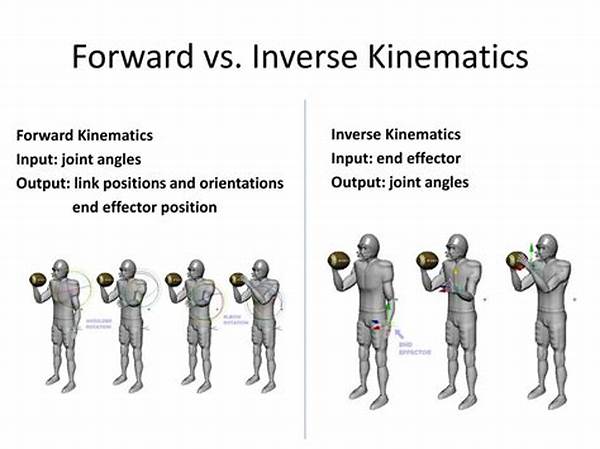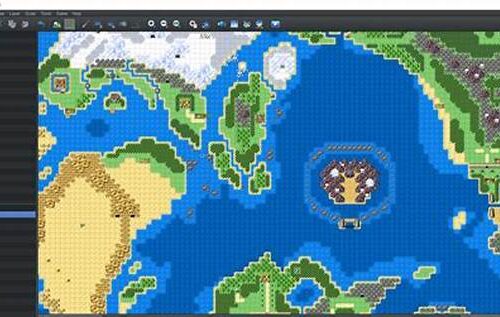Hey there, animation enthusiasts! Today, we’re diving into the fascinating world of kinematic and dynamic animations. Now, I know what you might be thinking: “Kinematic and dynamic animations? That sounds complex!” But fear not! We’re going to break it down and explore the marvelous intricacies of these animation styles. So, get comfy with your favorite cup of coffee, and let’s get started on this animated journey!
Read Now : Dynamic Environment Simulation Systems
Exploring the Intricacies
So, what exactly are kinematic and dynamic animations? Let’s talk about this in the simplest of terms. Kinematic animations are all about defining an object’s motion using a set of predetermined parameters. It’s like planning a road trip with every stop and turn laid out beforehand. This method is often employed in scenarios where precision and predictability are key—like robotic arms working in an assembly line.
On the flip side, dynamic animations add a splash of spontaneity and realism. Imagine a leaf fluttering unpredictably down from a tree or the chaos of a crashing wave. Dynamic animations try to simulate real-world physics to bring a more authentic and natural feel to animations. The beauty of dynamic animation lies in its ability to surprise and imitate the world around us with stunning accuracy. Kinematic and dynamic animations each have their strengths, and understanding when to use which can elevate any project to new heights.
In the realm of video games and animations, both styles play significant roles. Kinematic animations offer control and predictability, which are vital in ensuring the user’s or viewer’s experience is smooth and engaging. Meanwhile, dynamic animations can inject a sense of life and vibrancy that captivates audiences. Balancing these two styles is akin to mastering a delicate dance, creating an experience that is both reliable and thrilling.
Practical Applications
1. Video Games: Kinematic animations structure character movements, while dynamic animations bring unexpected elements like flying debris from explosions.
2. Robotics: Robots rely on kinematic animations for tasks like assembly, ensuring precise and repetitive actions.
3. Film Special Effects: Dynamic animations create realistic explosions and weather effects that wow audiences.
4. Virtual Reality: Both kinematic and dynamic animations work together to create immersive and interactive environments.
5. Simulations: From flight to engineering simulations, kinematic and dynamic animations are used to mimic real-world scenarios accurately.
The Art Behind the Movement
Behind every jaw-dropping animation, there’s a touch of technical wizardry—enter kinematic and dynamic animations. For those diving into animation, understanding these methods opens up a world of creative possibilities. With kinematics, you have the power to control and tailor the experience to your precise vision. Meanwhile, dynamic animation dares you to push the boundaries, letting simulations dictate outcomes that can be as unpredictable as life itself.
Animation studios are constantly experimenting with these techniques to bring their characters and worlds to pulsating life. Using algorithms, they craft nuanced movements that turn simple characters into multi-layered personas. Whether it’s a character brushing their hair or a car chase scene where each crash feels real, the use of kinematic and dynamic animations plays a significant part in these storytelling feats.
Ultimately, an animator’s choice of kinematic or dynamic animations depends on the story they wish to tell and the emotional responses they aim to evoke. It’s this artistic decision that transforms a simple sequence into a compelling narrative, capturing the imagination of audiences worldwide.
The Balance of Styles
Getting the balance right between kinematic and dynamic animations is an art. When it clicks, the results can be magical, combining the predictability of kinematic animations with the realism of dynamic animations. Let’s break it down:
1. Storytelling Impact: Dynamic animations can convey emotions through fluid and natural movements, making audiences relate deeply to characters.
2. Precision vs. Spontaneity: Kinematic animations excel in scenarios requiring strict control, such as medical simulations. Meanwhile, dynamic animations introduce randomness needed for realistic physics-based animations.
3. Audience Engagement: A balanced mix can enhance engagement, as viewers are drawn to both the predictable and unexpected elements in animations.
Read Now : “reducing Lag In Godot Engine”
4. Realism and Suspension of Disbelief: By simulating reality with dynamic animations, while achieving meticulous control with kinematic techniques, animations become believable.
5. Technical Considerations: Kinematic animations often require less computational power, making them ideal for real-time applications, whereas dynamics can be more resource-intensive but rewarding in rendering lifelike visuals.
6. Application Specificity: Kinematic and dynamic animations are chosen based on the desired outcome, be it educational, entertainment, or interactive platforms.
7. Animation Industry Trends: As technology evolves, the lines between kinematic and dynamic animations blur, enabling seamless integration.
8. Advancements in AI: Artificial Intelligence promises to bring innovative solutions to blend the predictability of kinematic animations with the natural feel of dynamic animations automatically.
9. Toolsets and Software: Software developers provide tools catering to both styles, allowing animators to finely tune their creations.
10. Audience Expectation: Today’s audience is savvy, expecting animations that replicate reality while engaging their imagination.
Bringing It All Together
The journey through the world of kinematic and dynamic animations is ongoing and ever-evolving. With new technologies and techniques emerging, animators continually discover innovative ways to integrate these elements into their projects. By understanding and mastering both approaches, creators can enhance storytelling, bringing a palpable sense of wonder and depth to their animations.
Emerging software and AI tools mean the boundaries between kinematic and dynamic animations can often overlap, giving rise to a new frontier in animation technology. Innovation in this space promises more efficient workflows and even more awe-inspiring creations.
Whether you’re an aspiring animator or a seasoned professional, embracing the beauty of kinematic and dynamic animations can elevate your work, pushing the limits of what’s possible and captivating audiences with stories yet to be told. As you explore these approaches, remember: the magic lies not only in the technical execution but in the story you wish to tell through your vibrant, animated world. Happy animating!
Final Thoughts and Future Prospects
Kinematic and dynamic animations prove that animation isn’t just about making things move—it’s about emotion, story, and breathing life into digital creations. Encompassing technical skill and creative expression, these animations allow both audiences and creators to experience something truly extraordinary.
As technology continues to evolve, the future of kinematic and dynamic animations looks bright. With virtual reality, augmented reality, and AI shaping the landscape, the possibilities are virtually limitless. Animators have at their disposal an ever-expanding toolkit to push creative boundaries and bring more immersive experiences to their audiences.
In summary, the balance and application of kinematic and dynamic animations are key to creating engaging, realistic, and moving visual stories. Whether for entertainment, education, or simulation, mastering these techniques opens endless potential for storytelling that captivates and inspires. So, as you create and animate, let these tools guide your stories with precision, passion, and a touch of magic.




